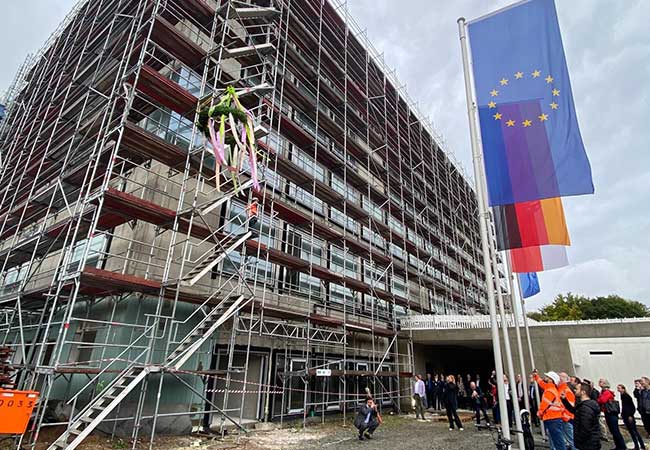The development of Goethe University Frankfurt’s Riedberg Campus into a natural sciences hub is taking a major step forward. During the traditional topping out ceremony, held on September 26, investors, builders and guests gathered to celebrate the completion of the chemical institutes’ shell as well as a new technical center. The Hessian federal government is financing the €90 million project through its HEUREKA funding line for institutions of higher education. The finished building is due to be handed over to the university in the fall of 2026.

Speaking at the ceremony, Hessian Finance Minister Prof. Dr. R. Alexander Lorz said: “€90 million is a lot to invest in a new building – and not just in times of tight public coffers. All told, the state of Hesse has invested some €350 million in Riedberg Campus since 2007 through the HEUREKA funding line – and almost €1 billion in Goethe University Frankfurt as a whole. These are astronomical sums – and yet it is money well spent. After all, the new building for the chemical institutes, including its new technical center, constitutes a milestone for Riedberg Campus – which has undergone a remarkable development in recent years and today rightly calls itself a Science City, a place where science has truly found a home. At the same time, the age of the old chemistry building is starting to show. This new state-of-the-art institute creates the conditions required for further decades of outstanding research and teaching here in Frankfurt – and that is certainly a good investment in our state’s future.”
Hessian science minister Timon Gremmels added: “Chemical research has traditionally played an important role in the Rhine-Main area. When it comes to its students’ education, Goethe University Frankfurt also cooperates with leading chemical and pharmaceutical companies. Once the next construction phases of the chemical institutes are completed, and the new building for computer science and mathematics – which is also currently under construction – is complete, the university will have taken a big step towards its goal of bringing the natural sciences together on Riedberg Campus. Not only will this further improve the conditions for high-quality teaching and research on this campus, it will complete the university’s plans for the ‘Science City Riedberg’.”
Goethe University President Prof. Enrico Schleiff said: “Some 50 years ago, it was the chemistry building’s construction that laid the foundation for the new natural sciences campus in Riedberg. The fact that we are now on the verge of completing a state-of-the-art building complex for our chemistry department shows just how future-oriented research, teaching and knowledge transfer were and are in the new Science City Riedberg. Not only will interdisciplinary and international research continue to be conducted inside this modern building, it will include all the other subjects and non-university research institutions located on Riedberg Campus. It takes modern infrastructures to make this possible – something we now have thanks to the state of Hesse’s HEUREKA program. Modern infrastructures are the key prerequisite not only for excellent basic research and the basis for local innovations, but also for worldwide networking to strengthen our region’s internationality, and for modern study and teaching to train future specialists.”
The chemical institutes’ first construction phase comprised the building’s western part, including the adjacent underground technical center, which forms the link to the second construction phase, explained Thomas Platte, director of LBIH, the Hessian state administration’s central construction and real estate service provider.
The new building will include flexible research areas for multi-purpose practical work, a chemicals storage and special laboratories for inorganic and analytical chemistry as well as for organic chemistry and chemical biology. The four-story building has a total floor space of 6,711 square meters. A second construction phase will follow to accommodate all the different uses.
For many years, the old chemistry department building, erected in 1973, was the only building on the campus, which used to be called Niederursel. It was only in the 1990s that the Biocenter was also built on the site. As part of the gradual withdrawal from Bockenheim Campus and the subsequent site reorganization, combined with the HEUREKA program, Riedberg Campus became Goethe University’s natural science center, with many additional institutions deciding to settle here. The Faculty of Physics (2005), the Faculty of Geosciences and Geography (2007), the Central Workshop (2009), the Biologicum (2011) and the research building for high-field spectroscopy to study macromolecular complexes (2023), among others, followed in several new buildings. In addition, many other research institutes (including the Max Planck Institute for Brain Research, the Max Planck Institute for Biophysics, the Frankfurt Institute for Advanced Studies and the FiZ Frankfurt Innovation Center) as well as non-university institutions such as student dormitories now have been established on campus.
HEUREKA is the German acronym for “Higher Education Development and Rebuilding Program: All-Round Renewal, Concentration and Expansion of Research and Reaching in Hesse” (Hochschul Entwicklungs- und Umbauprogramm: RundErneuerung, Konzentration und Ausbau von Forschung und Lehre in Hessen). Launched in 2007, HEUREKA makes available a total of €5.7 billion up to 2031 to finance construction projects, thereby offering long-term planning security for Hesse’s universities, universities of applied sciences and art colleges.
Topping-out ceremonies were traditionally held to mark the completion of the carpenter’s roof truss. Today, the ceremony usually takes place once a building’s shell has been completed. The festivities usually take place during working hours on the construction site itself, since this is where the craftsmen and builders together celebrate the completion of this significant work step. This tradition is upheld by the building’s contractors, the state of Hesse and LBIH. The ceremony is also reason to celebrate for future building users and the planning offices involved.
Source: Pressemitteilung Hessisches Ministerium der Finanzen








